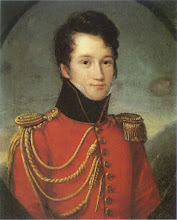By Imperial Order, Julian II Contemplates the Head
of Gallus[1]
(354 C.E.)
Night! Nicomedia[2].
By the Western gate
My brother’s head- a
warning on a spear.
Eyes raven-ravaged; blond
curls inspissate
With blood clots;
noseless; mouth agape with fear.
Crowned Lord of blowflies,
he may contemplate
The crooked Eastern road
that led him here,[3]
Moaning: ’Spare me! My bitch wife[4]
sealed my fate,
Eusebius.[5]
I am Caesar!’ His sneer
And vicious, ice-blue
stare still taint my dreams
Of boyhood in Bithynia[6],
where we played
As wolves bloodied the
empire. Did his screams
Trouble his
kinsmen-killer?[7]
I’m afraid!
Even God’s Son, nailed to
his cross, now seems
Transfixed in terror at
the world He made.
[1] Julian’s dissipated elder half-brother, Flavius
Claudius Constantius Gallus
(326-354). Made Caesar
(Vice-Emperor) from 351 to 354 by Constantius II, he was eventually lured away
from his power base in Antioch (modern Syria) and executed in Pola (modern Pula, Croatia),
when the paranoid Emperor suspected him of plotting against him. His face may well have been mutilated before
his beheading.
[2] Modern Izmit,
Turkey. The
eastern and most senior capital city of the Roman empire from 286-324 and
interim capital city from 324 to 330, when Byzantium (Nova Roma) took its place.
[3] From Antioch, a
major cultural and administrative centre on the Orontes, capital of Syria, and
scene of Gallus’s misrule.
[4] Gallus’s wife, Constantina, eldest daughter of
Constantine the Great, sister of Constantius II, had died of a fever in Bithynia just
before the arrest of Gallus. The grief-stricken emperor, furious at hearing
that Gallus had laid the blame for his misrule on her, ordered his execution.
Though now venerated as a saint (!), Constantina, who was at least ten years
older than Gallus and certainly controlled him, was likened by Ammianus
Marcellinus in his History (book 14: The Cruelty of the Caesar Gallus) to ‘a Fury in mortal form, incessantly adding
fuel to her husband’s rage and as thirsty for human blood as she.’ Her hallowed, porphyry sarcophagus is now in
the Vatican museum.
[5] The powerful Grand Chamberlain (Praepositus cubiculi) responsible for the trial and execution of
Gallus. He is said to have ignored the
emperor’s revocation of the order to execute Gallus. However, since Ammianus
tells us that Constantius never revoked a death sentence, we may dismiss this
as a Christian invention.
[6] A Roman province in modern Turkey, adjoining the Propontis, Thracian
Bosporus and the Black Sea (Euxine).
[7] Constantius had been responsible for the murderous
purge of the imperial family after the death of Constantine I., including
Julian’s father.
COPYRIGHT (C) 2010 J D FRODSHAM




No comments:
Post a Comment